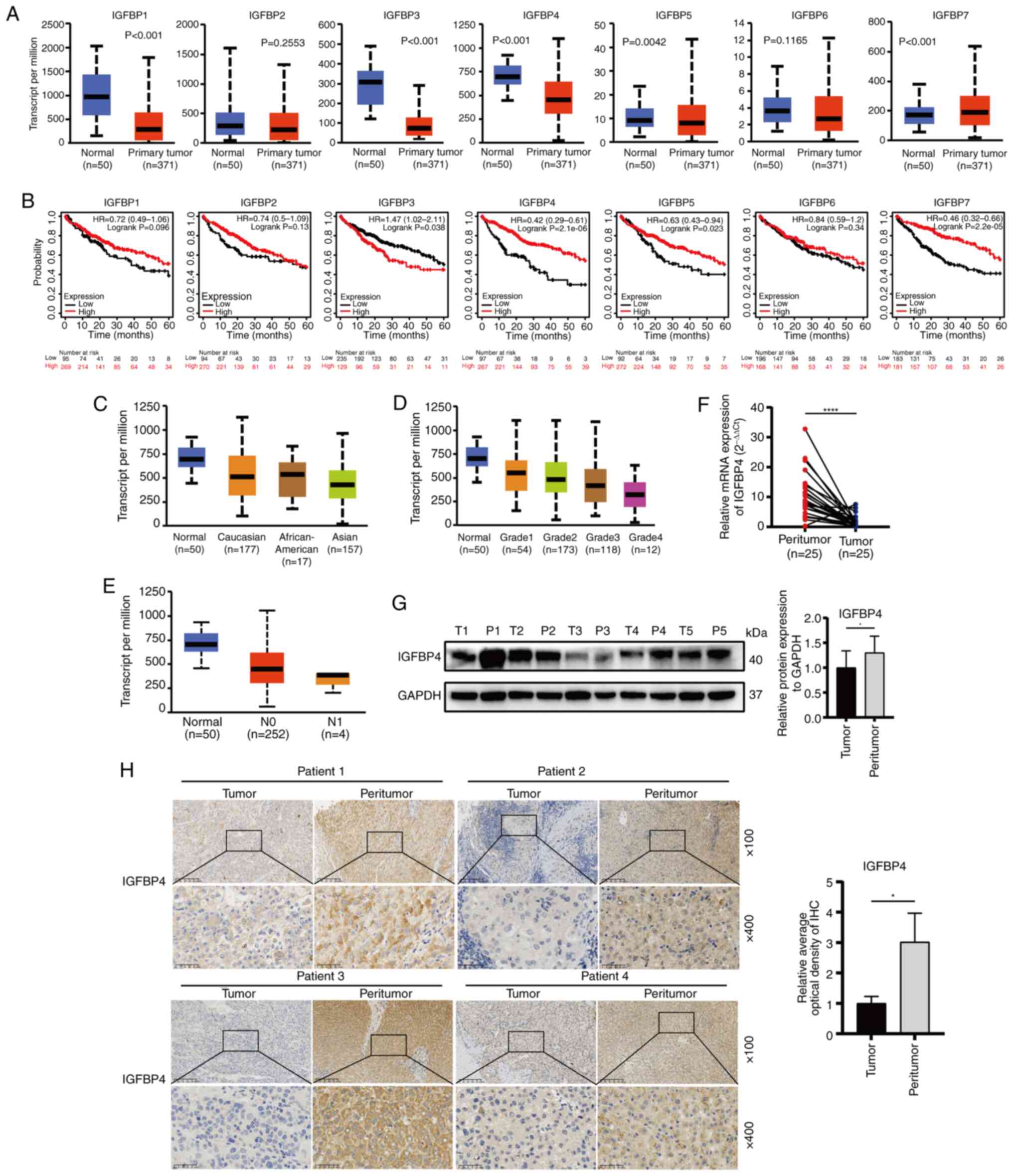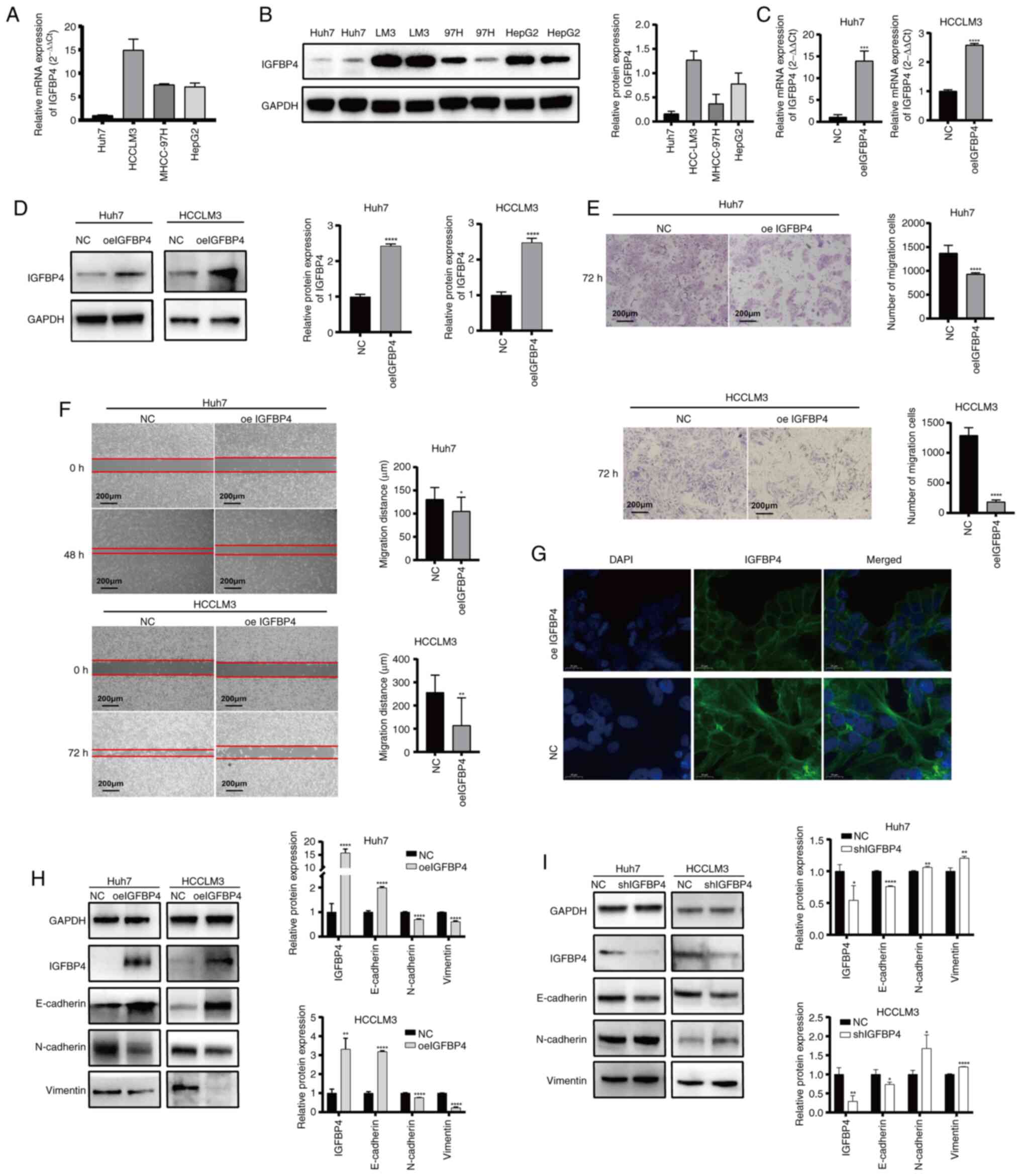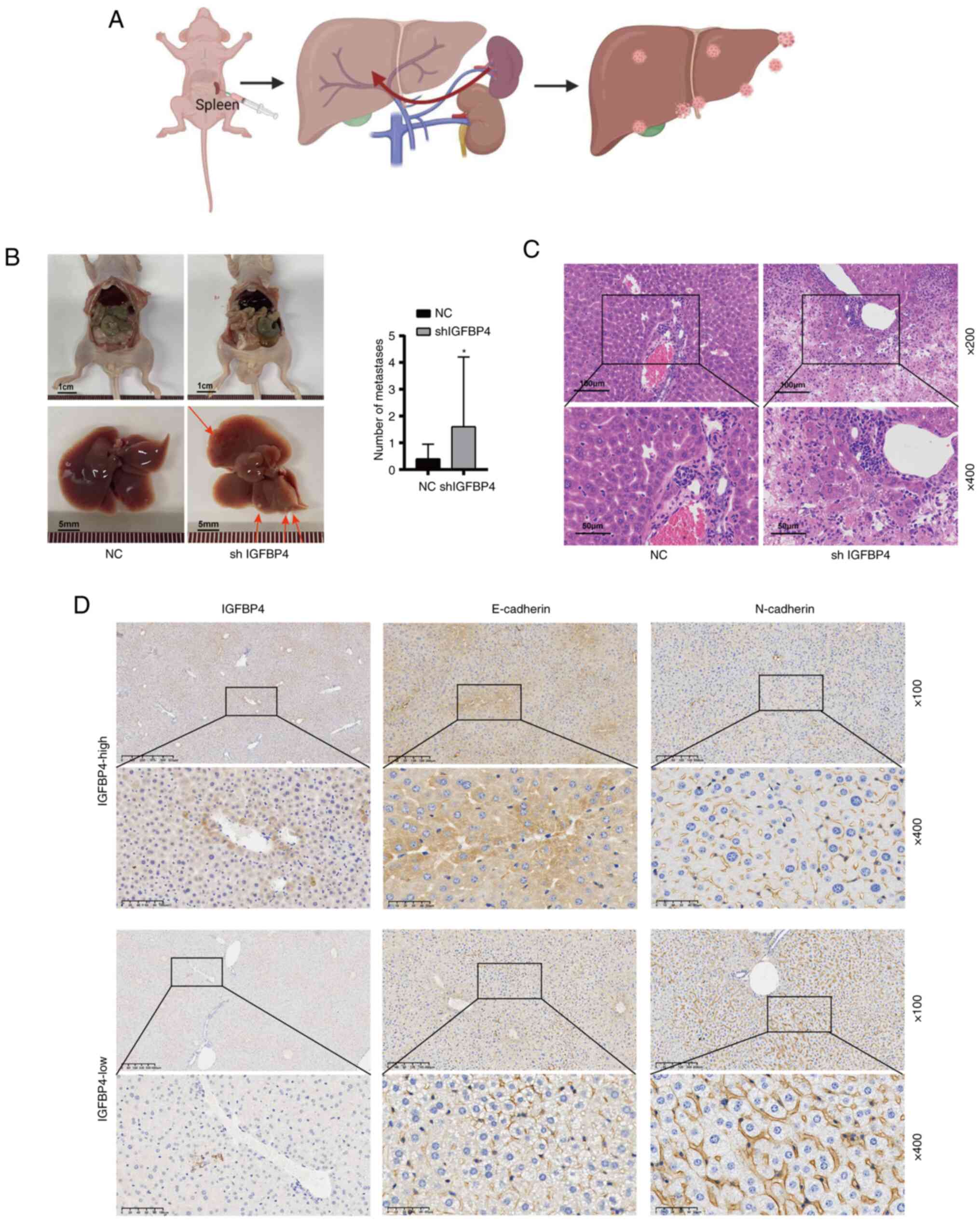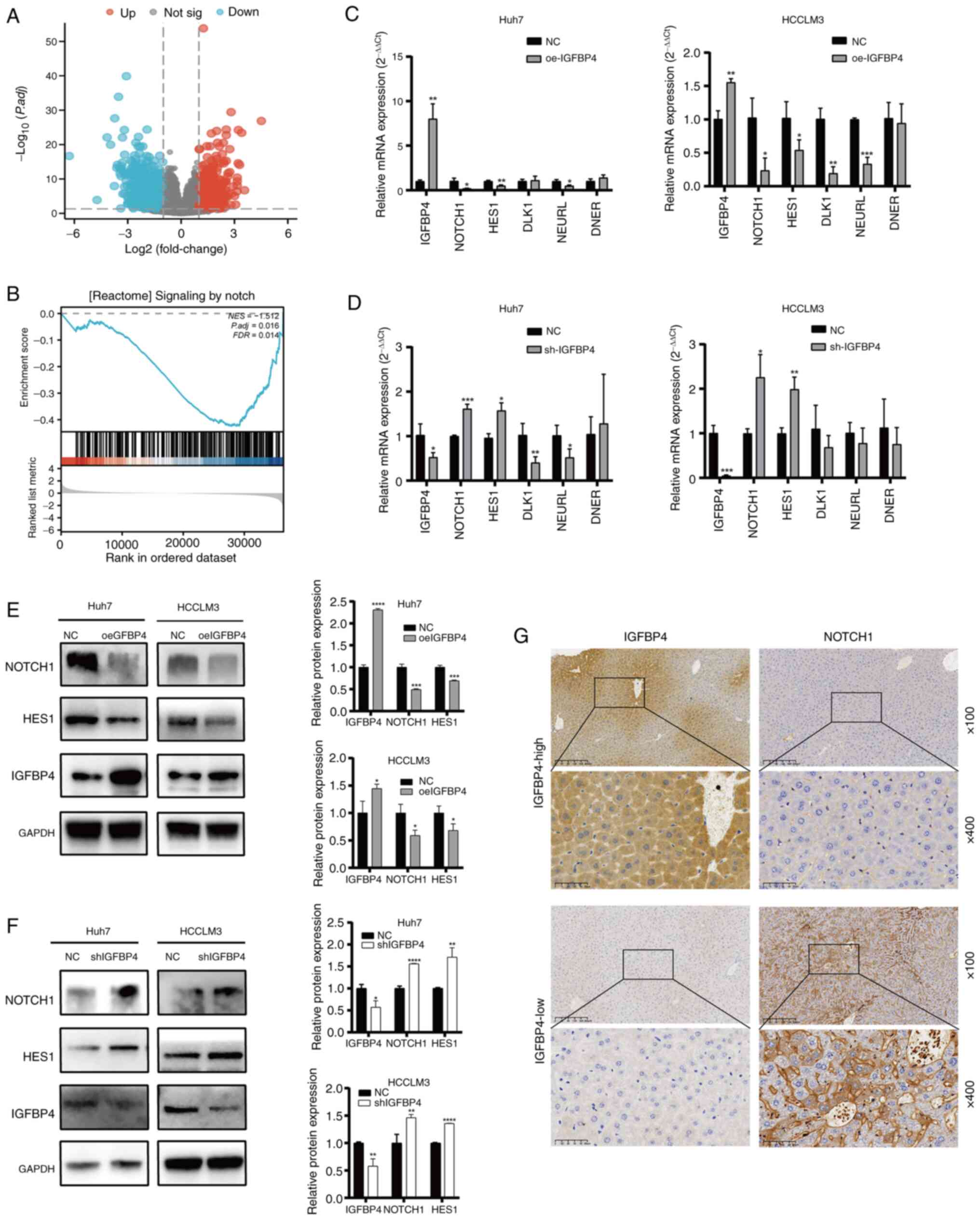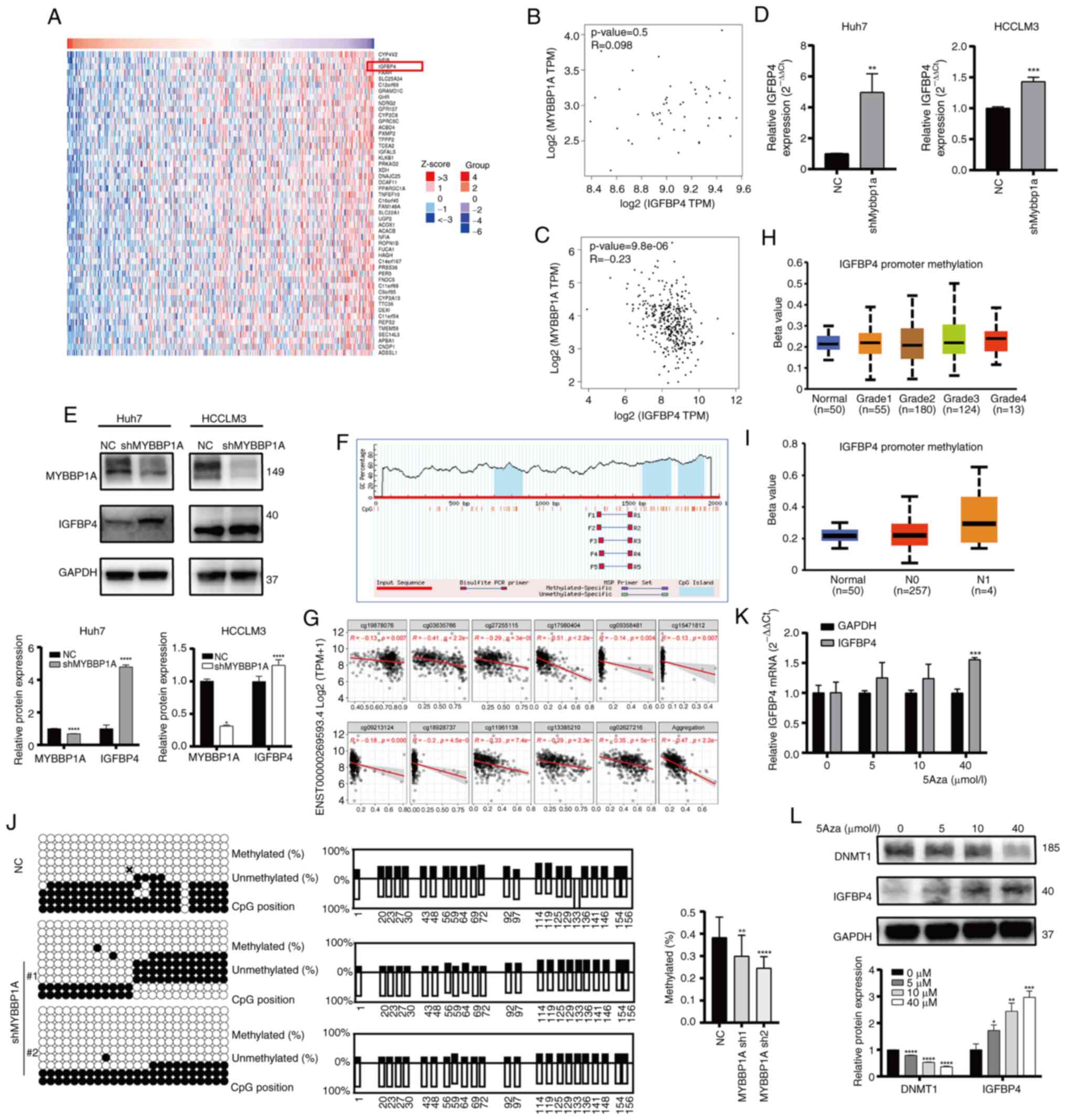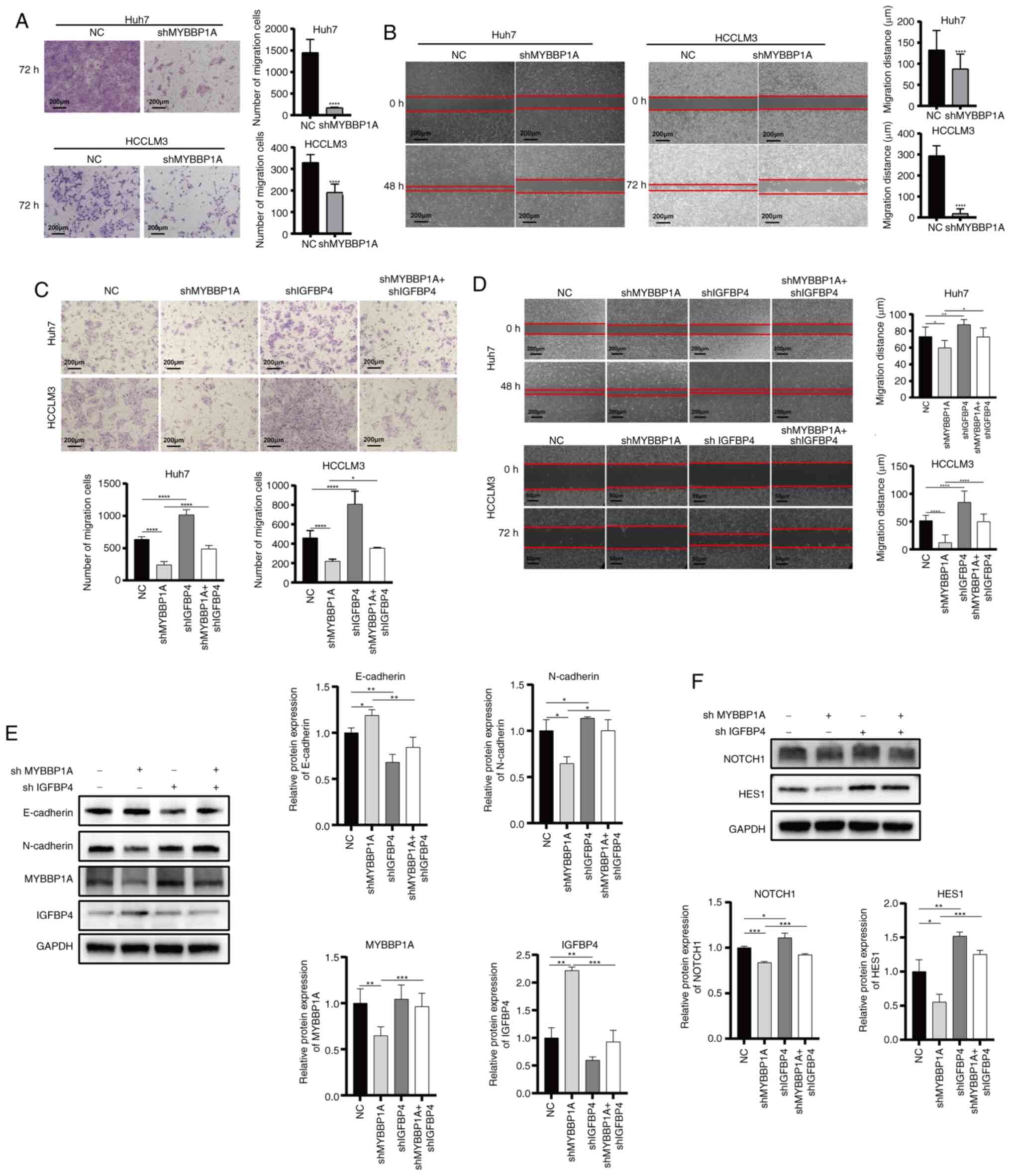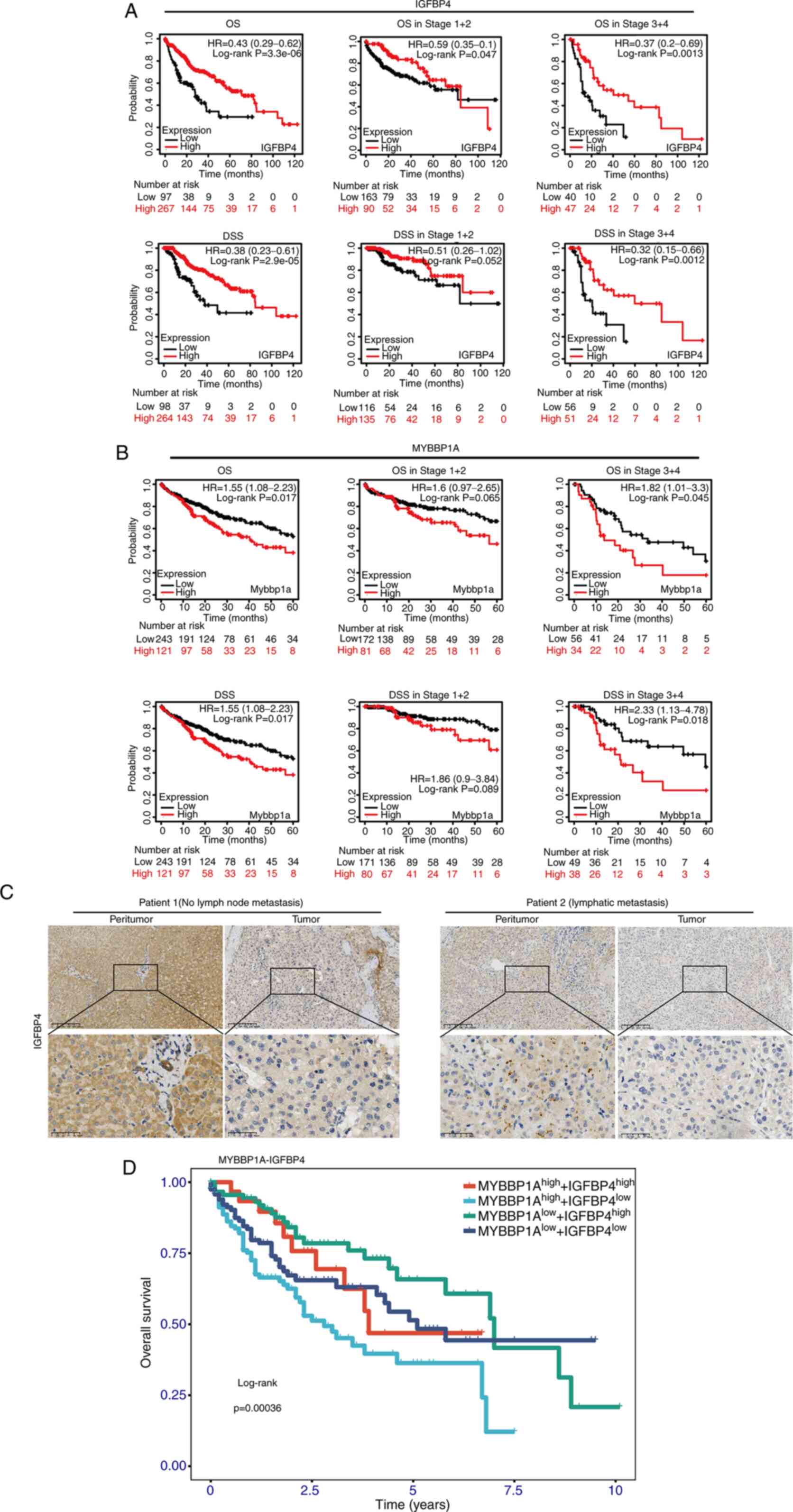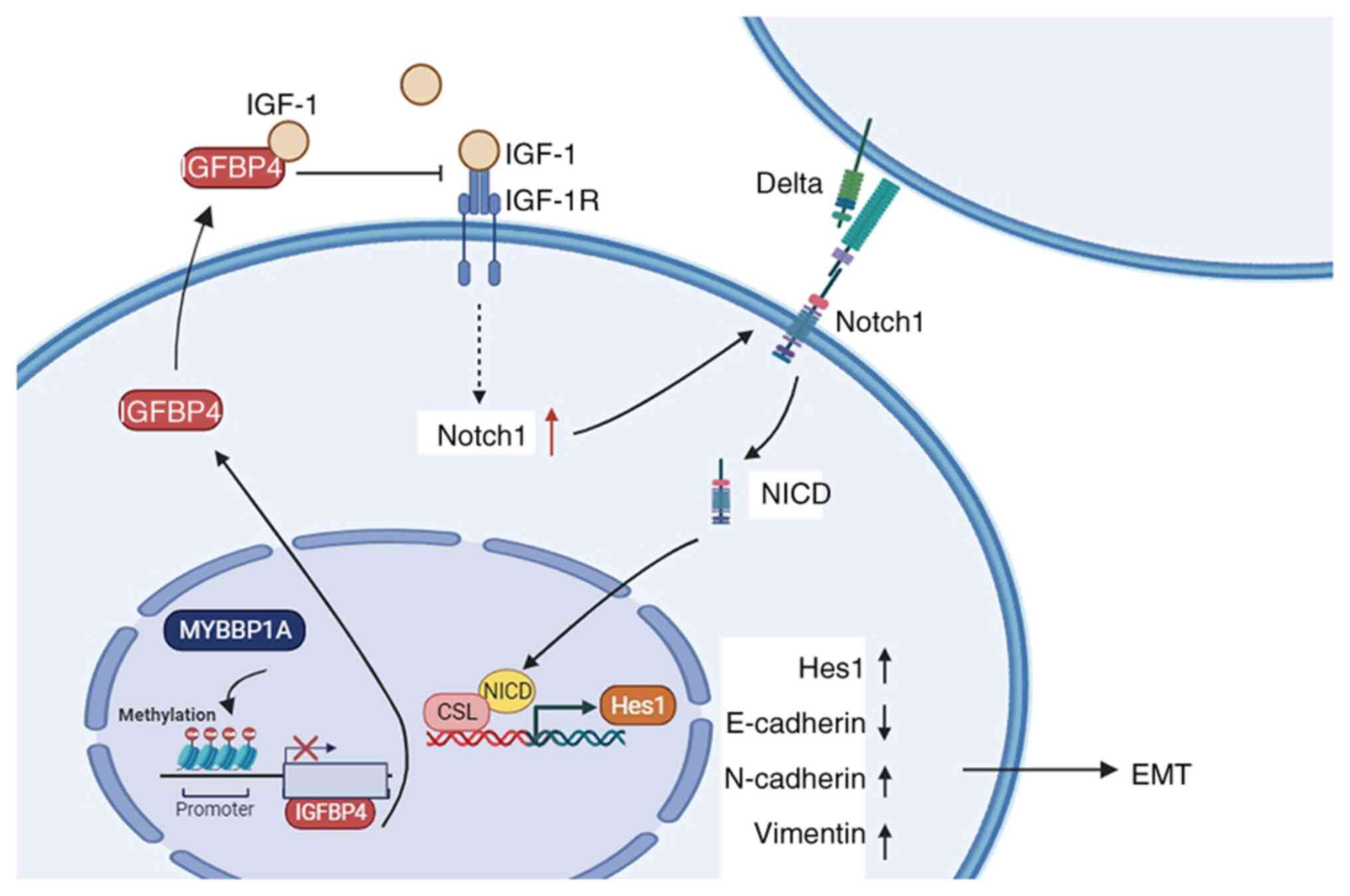|
1
|
Siegel RL, Miller KD, Wagle NS and Jemal
A: Cancer statistics, 2023. CA Cancer J Clin. 73:17–48. 2023.
View Article : Google Scholar : PubMed/NCBI
|
|
2
|
Sung H, Ferlay J, Siegel RL, Laversanne M,
Soerjomataram I, Jemal A and Bray F: Global cancer statistics 2020:
GLOBOCAN estimates of incidence and mortality worldwide for 36
cancers in 185 countries. CA Cancer J Clin. 71:209–249. 2021.
View Article : Google Scholar : PubMed/NCBI
|
|
3
|
Llovet JM, Kelley RK, Villanueva A, Singal
AG, Pikarsky E, Roayaie S, Lencioni R, Koike K, Zucman-Rossi J and
Finn RS: Hepatocellular carcinoma. Nat Rev Dis Primers. 7:62021.
View Article : Google Scholar : PubMed/NCBI
|
|
4
|
Xia C, Dong X, Li H, Cao M, Sun D, He S,
Yang F, Yan X, Zhang S, Li N and Chen W: Cancer statistics in China
and United States, 2022: Profiles, trends, and determinants. Chin
Med J (Engl). 135:584–590. 2022. View Article : Google Scholar : PubMed/NCBI
|
|
5
|
Kulik L and El-Serag HB: Epidemiology and
management of hepatocellular carcinoma. Gastroenterology.
156:477–491.e1. 2019. View Article : Google Scholar
|
|
6
|
Yang JD, Hainaut P, Gores GJ, Amadou A,
Plymoth A and Roberts LR: A global view of hepatocellular
carcinoma: Trends, risk, prevention and management. Nat Rev
Gastroenterol Hepatol. 16:589–604. 2019. View Article : Google Scholar : PubMed/NCBI
|
|
7
|
Durai R, Davies M, Yang W, Yang SY,
Seifalian A, Goldspink G and Winslet M: Biology of insulin-like
growth factor binding protein-4 and its role in cancer (review).
Int J Oncol. 28:1317–1325. 2006.PubMed/NCBI
|
|
8
|
Yang B, Zhang L, Cao Y, Chen S, Cao J, Wu
D, Chen J, Xiong H, Pan Z, Qiu F, et al: Overexpression of lncRNA
IGFBP4-1 reprograms energy metabolism to promote lung cancer
progression. Mol Cancer. 16:1542017. View Article : Google Scholar : PubMed/NCBI
|
|
9
|
Chen W, Hu L, Lu X, Wang X, Zhao C, Guo C,
Li X, Ding Y, Zhao H, Tong D, et al: The RNA binding protein MEX3A
promotes tumor progression of breast cancer by post-transcriptional
regulation of IGFBP4. Breast Cancer Res Treat. 201:353–366. 2023.
View Article : Google Scholar : PubMed/NCBI
|
|
10
|
Li C, Cao Y, Zhang L, Li J, Wu H, Ling F,
Zheng J, Wang J, Li B, He J, et al: LncRNA IGFBP4-1 promotes tumor
development by activating Janus kinase-signal transducer and
activator of transcription pathway in bladder urothelial carcinoma:
Retraction. Int J Biol Sci. 19:48332023. View Article : Google Scholar : PubMed/NCBI
|
|
11
|
Conover CA: Insulin-like growth
factor-binding proteins and bone metabolism. Am J Physiol
Endocrinol Metab. 294:E10–E14. 2008. View Article : Google Scholar
|
|
12
|
Maridas DE, DeMambro VE, Le PT, Mohan S
and Rosen CJ: IGFBP4 is required for adipogenesis and influences
the distribution of adipose depots. Endocrinology. 158:3488–3500.
2017. View Article : Google Scholar : PubMed/NCBI
|
|
13
|
Weng X, Wu J, Lv Z, Peng C, Chen J, Zhang
C, He B, Tong R, Hu W, Ding C, et al: Targeting MYBBP1A suppresses
HCC progression via inhibiting IGF1/AKT pathway by CpG islands
hypo-methylation dependent promotion of IGFBP5. EBioMedicine.
44:225–236. 2019. View Article : Google Scholar : PubMed/NCBI
|
|
14
|
Livak KJ and Schmittgen TD: Analysis of
relative gene expression data using real-time quantitative PCR and
the 2(-Delta Delta C(T)) Method. Methods. 25:402–408. 2001.
View Article : Google Scholar
|
|
15
|
Ru J, Lu J, Ge J, Ding B, Su R, Jiang Y,
Sun Y, Ma J, Li Y, Sun J, et al: IRGM is a novel regulator of PD-L1
via promoting S6K1-mediated phosphorylation of YBX1 in
hepatocellular carcinoma. Cancer Lett. 581:2164952024. View Article : Google Scholar
|
|
16
|
Hu X, Chen G, Huang Y, Cheng Q, Zhuo J, Su
R, He C, Wu Y, Liu Z, Yang B, et al: Integrated multiomics reveals
silencing of has_circ_0006646 Promotes TRIM21-Mediated NCL
ubiquitination to inhibit hepatocellular carcinoma metastasis. Adv
Sci (Weinh). 11:e23069152024. View Article : Google Scholar : PubMed/NCBI
|
|
17
|
Workman P, Aboagye EO, Balkwill F, Balmain
A, Bruder G, Chaplin DJ, Double JA, Everitt J, Farningham DA,
Glennie MJ, et al: Guidelines for the welfare and use of animals in
cancer research. Br J Cancer. 102:1555–1577. 2010. View Article : Google Scholar : PubMed/NCBI
|
|
18
|
Sugase T, Lam BQ, Danielson M, Terai M,
Aplin AE, Gutkind JS and Sato T: Development and optimization of
orthotopic liver metastasis xenograft mouse models in uveal
melanoma. J Transl Med. 18:2082020. View Article : Google Scholar : PubMed/NCBI
|
|
19
|
Purohit A, Saxena S, Varney M, Prajapati
DR, Kozel JA, Lazenby A and Singh RK: Host Cxcr2-Dependent
regulation of pancreatic cancer growth, angiogenesis, and
metastasis. Am J Pathol. 191:759–771. 2021. View Article : Google Scholar : PubMed/NCBI
|
|
20
|
Seki K, Yamaguchi A, Goi T, Nakagawara G,
Matsukawa S, Urano T and Furukawa K: Inhibition of liver metastasis
formation by anti-CD44 variant exon 9 monoclonal antibody. Int J
Oncol. 11:1257–1261. 1997.PubMed/NCBI
|
|
21
|
Ohta T, Futagami F, Tajima H, Kitagawa H,
Kayahara M, Nagakawa T, Miwa K, Yamamoto M, Iseki S, Nakanuma Y and
Terada T: Inhibitory effect of a serine protease inhibitor, FOY-305
on the invasion and metastasis of human pancreatic cancers. Int J
Oncol. 11:813–817. 1997.PubMed/NCBI
|
|
22
|
Takesue S, Ohuchida K, Shinkawa T, Otsubo
Y, Matsumoto S, Sagara A, Yonenaga A, Ando Y, Kibe S, Nakayama H,
et al: Neutrophil extracellular traps promote liver micrometastasis
in pancreatic ductal adenocarcinoma via the activation of
cancer-associated fibroblasts. Int J Oncol. 56:596–605.
2020.PubMed/NCBI
|
|
23
|
Tauriello DVF, Palomo-Ponce S, Stork D,
Berenguer-Llergo A, Badia-Ramentol J, Iglesias M, Sevillano M,
Ibiza S, Cañellas A, Hernando-Momblona X, et al: TGFβ drives immune
evasion in genetically reconstituted colon cancer metastasis.
Nature. 554:538–543. 2018. View Article : Google Scholar : PubMed/NCBI
|
|
24
|
Wang Z, Li Y, Kong D and Sarkar FH: The
role of NOTCH signaling pathway in epithelial-mesenchymal
transition (EMT) during development and tumor aggressiveness. Curr
Drug Targets. 11:745–751. 2010. View Article : Google Scholar : PubMed/NCBI
|
|
25
|
Yang X, Bai Q, Chen W, Liang J, Wang F, Gu
W, Liu L, Li Q, Chen Z, Zhou A, et al: m(6) A-Dependent Modulation
via IGF2BP3/MCM5/NOTCH Axis Promotes Partial EMT and LUAD
Metastasis. Adv Sci (Weinh). 10:e22067442023. View Article : Google Scholar : PubMed/NCBI
|
|
26
|
Yuan X, Wu H, Han N, Xu H, Chu Q, Yu S,
Chen Y and Wu K: NOTCH signaling and EMT in non-small cell lung
cancer: Biological significance and therapeutic application. J
Hematol Oncol. 7:872014. View Article : Google Scholar : PubMed/NCBI
|
|
27
|
Finn RS, Qin S, Ikeda M, Galle PR, Ducreux
M, Kim TY, Kudo M, Breder V, Merle P, Kaseb AO, et al: Atezolizumab
plus bevacizumab in unresectable hepatocellular carcinoma. N Engl J
Med. 382:1894–1905. 2020. View Article : Google Scholar : PubMed/NCBI
|
|
28
|
Xu L, Shao Z, Fang X, Xin Z, Zhao S, Zhang
H, Zhang Y, Zheng W, Yu X, Zhang Z and Sun L: Exploring precision
treatments in immune-mediated inflammatory diseases: Harnessing the
infinite potential of nucleic acid delivery. Exploration.
202:301652024.
|
|
29
|
Sato H, Sakaeda M, Ishii J, Kashiwagi K,
Shimoyamada H, Okudela K, Tajiri M, Ohmori T, Ogura T, Woo T, et
al: Insulin-like growth factor binding protein-4 gene silencing in
lung adenocarcinomas. Pathol Int. 61:19–27. 2011. View Article : Google Scholar
|
|
30
|
Mazerbourg S, Callebaut I, Zapf J, Mohan
S, Overgaard M and Monget P: Up date on IGFBP-4: Regulation of
IGFBP-4 levels and functions, in vitro and in vivo. Growth Horm IGF
Res. 14:71–84. 2004. View Article : Google Scholar : PubMed/NCBI
|
|
31
|
Praveen Kumar VR, Sehgal P, Thota B, Patil
S, Santosh V and Kondaiah P: Insulin like growth factor binding
protein 4 promotes GBM progression and regulates key factors
involved in EMT and invasion. J Neurooncol. 116:455–464. 2014.
View Article : Google Scholar : PubMed/NCBI
|
|
32
|
Ma X, Zhao D, Liu S, Zuo J, Wang W, Wang
F, Li Y, Ding Z, Wang J and Wang X: FERMT2 upregulation in CAFs
enhances EMT of OSCC and M2 macrophage polarization. Oral Dis.
30:991–1003. 2024. View Article : Google Scholar
|
|
33
|
Diehl D, Hoeflich A, Wolf E and Lahm H:
Insulin-like growth factor (IGF)-binding protein-4 inhibits colony
formation of colorectal cancer cells by IGF-independent mechanisms.
Cancer Res. 64:1600–1603. 2004. View Article : Google Scholar : PubMed/NCBI
|
|
34
|
Li W, Sun D, Lv Z, Wei Y, Zheng L, Zeng T
and Zhao J: Insulin-like growth factor binding protein-4 inhibits
cell growth, migration and invasion, and downregulates COX-2
expression in A549 lung cancer cells. Cell Biol Int. 41:384–391.
2017. View Article : Google Scholar : PubMed/NCBI
|
|
35
|
Tao L, Wang Y, Shen Z, Cai J, Zheng J, Xia
S, Lin Z, Wan Z, Qi H, Jin R, et al: Activation of IGFBP4 via
unconventional mechanism of miRNA attenuates metastasis of
intrahepatic cholangiocarcinoma. Hepatol Int. 18:91–107. 2024.
View Article : Google Scholar
|
|
36
|
Lee YY, Mok MT, Kang W, Yang W, Tang W, Wu
F, Xu L, Yan M, Yu Z, Lee SD, et al: Loss of tumor suppressor
IGFBP4 drives epigenetic reprogramming in hepatic carcinogenesis.
Nucleic Acids Res. 46:8832–8847. 2018. View Article : Google Scholar : PubMed/NCBI
|
|
37
|
Zhang N, Lin C, Huang X, Kolbanovskiy A,
Hingerty BE, Amin S, Broyde S, Geacintov NE and Patel DJ:
Methylation of cytosine at C5 in a CpG sequence context causes a
conformational switch of a benzo[a]pyrene diol epoxide-N2-guanine
adduct in DNA from a minor groove alignment to intercalation with
base displacement. J Mol Biol. 346:951–965. 2005. View Article : Google Scholar : PubMed/NCBI
|
|
38
|
Hernandez-Meza G, von Felden J,
Gonzalez-Kozlova EE, Garcia-Lezana T, Peix J, Portela A, Craig AJ,
Sayols S, Schwartz M, Losic B, et al: DNA methylation profiling of
human hepatocarcinogenesis. Hepatology. 74:183–199. 2021.
View Article : Google Scholar
|
|
39
|
Qi L, Sun B, Liu Z, Cheng R, Li Y and Zhao
X: Wnt3a expression is associated with epithelial-mesenchymal
transition and promotes colon cancer progression. J Exp Clin Cancer
Res. 33:1072014. View Article : Google Scholar : PubMed/NCBI
|
|
40
|
Zhang L, He S, Guan H, Zhao Y and Zhang D:
Circulating RNA ZFR promotes hepatocellular carcinoma cell
proliferation and epithelial-mesenchymal transition process through
miR-624-3p/WEE1 axis. Hepatobiliary Pancreat Dis Int. 23:52–63.
2024. View Article : Google Scholar
|
|
41
|
Jackstadt R, van Hooff SR, Leach JD,
Cortes-Lavaud X, Lohuis JO, Ridgway RA, Wouters VM, Roper J,
Kendall TJ, Roxburgh CS, et al: Epithelial NOTCH signaling rewires
the tumor microenvironment of colorectal cancer to drive
poor-prognosis subtypes and metastasis. Cancer Cell. 36:319–336.e7.
2019. View Article : Google Scholar : PubMed/NCBI
|
|
42
|
Chen S, Cai K, Zheng D, Liu Y, Li L, He Z,
Sun C and Yu C: RHBDL2 promotes the proliferation, migration, and
invasion of pancreatic cancer by stabilizing the N1ICD via the
OTUD7B and activating the NOTCH signaling pathway. Cell Death Dis.
13:9452022. View Article : Google Scholar : PubMed/NCBI
|
|
43
|
Hu S, Molina L, Tao J, Liu S, Hassan M,
Singh S, Poddar M, Bell A, Sia D, Oertel M, et al:
NOTCH-YAP1/TEAD-DNMT1 axis drives hepatocyte reprogramming into
intrahepatic cholangiocarcinoma. Gastroenterology. 163:449–465.
2022. View Article : Google Scholar : PubMed/NCBI
|
|
44
|
Kawaguchi K and Kaneko S: NOTCH signaling
and liver cancer. Adv Exp Med Biol. 1287:69–80. 2021. View Article : Google Scholar
|
|
45
|
Sivakumar R, Koga H, Selvendiran K,
Maeyama M, Ueno T and Sata M: Autocrine loop for IGF-I receptor
signaling in SLUG-mediated epithelial-mesenchymal transition. Int J
Oncol. 34:329–338. 2009.PubMed/NCBI
|
|
46
|
Baxter RC: Signaling pathways of the
insulin-like growth factor binding proteins. Endocr Rev.
44:753–778. 2023. View Article : Google Scholar : PubMed/NCBI
|
|
47
|
Medyouf H, Gusscott S, Wang H, Tseng JC,
Wai C, Nemirovsky O, Trumpp A, Pflumio F, Carboni J, Gottardis M,
et al: High-level IGF1R expression is required for
leukemia-initiating cell activity in T-ALL and is supported by
NOTCH signaling. J Exp Med. 208:1809–1822. 2011. View Article : Google Scholar : PubMed/NCBI
|
|
48
|
Totaro A, Castellan M, Di Biagio D and
Piccolo S: Crosstalk between YAP/TAZ and NOTCH Signaling. Trends
Cell Biol. 28:560–573. 2018. View Article : Google Scholar : PubMed/NCBI
|
|
49
|
Engel-Pizcueta C and Pujades C: Interplay
between NOTCH and YAP/TAZ pathways in the regulation of cell fate
during embryo development. Front Cell Dev Biol. 9:7115312021.
View Article : Google Scholar : PubMed/NCBI
|
|
50
|
Zhu H, Wang DD, Yuan T, Yan FJ, Zeng CM,
Dai XY, Chen ZB, Chen Y, Zhou T, Fan GH, et al: Multikinase
inhibitor CT-707 targets liver cancer by interrupting the
hypoxia-activated IGF-1R-YAP axis. Cancer Res. 78:3995–4006. 2018.
View Article : Google Scholar : PubMed/NCBI
|
|
51
|
Ngo MT, Peng SW, Kuo YC, Lin CY, Wu MH,
Chuang CH, Kao CX, Jeng HY, Lin GW, Ling TY, et al: A
yes-associated protein (YAP) and insulin-like growth factor 1
receptor (IGF-1R) signaling loop is involved in sorafenib
resistance in hepatocellular carcinoma. Cancers (Basel).
13:38122021. View Article : Google Scholar : PubMed/NCBI
|



